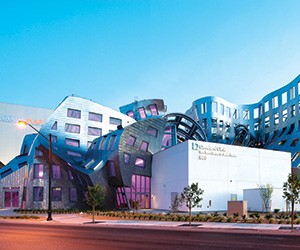Before the Strip there was downtown, the original Las Vegas founded in 1905 as a railroad stop. After Nevada legalized gambling in 1931, small gaming parlors began lining Fremont Street, setting the stage for a revolution in entertainment. Influenced by the neon-lit theaters of Broadway, Las Vegas harnessed electricity generated by nearby Hoover Dam to power Glitter Gulch, the arcade of hotel-casinos that followed the Golden Nugget’s opening in 1946.
Downtown was a neon super nova for decades, until changing times and tastes relegated the area into moribund obsolescence. Unable to compete with the mega-properties of the Strip, downtown’s revival began in 1995 with the Fremont Street Experience, a soaring five-block canopy of computerized light and sound effects. The visitors returned, but then the recession hit, and the momentum was lost.
Now, however, bright optimism is chasing away the twilight for good. Tony Hsieh, CEO of online retailer Zappos.com, has committed $350 million to his Downtown Project revitalization initiative, and with civic leaders passionately in support, capital and resolve are fueling a dynamic transformation already well under way.
“Visitors are quickly learning that downtown is the place to be,” says Las Vegas Mayor Carolyn Goodman. “Offering a vintage Vegas vibe, undeniable energy and exciting new artistic, cultural, dining and nightlife attractions, the renaissance of our city core is a truly exciting time for Las Vegas.”
From reincarnated hotels to futuristic new attractions, planners have options galore in ever-transforming downtown Vegas. PageBreak
Renewed Purposes
Having moved Zappos to an office park in nearby Henderson in 2004, Hsieh is now relocating the company to downtown’s old City Hall building. As Hsieh told Fortune last year, his motivation was to create a stimulating new environment for his employees.
“When you’re in a city, the bar or the restaurant becomes an extended conference room,” Hsieh says.
After recognizing a ready opportunity in downtown Las Vegas, his thinking changed from “building a campus to building a city.”
Bringing some 1,200 employees to live and work downtown, Hsieh’s move into City Hall highlights another significant theme of the district’s revival—preservation and reuse.
Contrary to the city’s time-honored tradition of dynamiting its past, projects such as the rebirth of the city’s first and oldest hotel, the Golden Gate, exemplify a new heritage-minded attitude to redevelopment. Opened in 1906 as the Hotel Nevada, this Fremont Street anchor, birthplace of the shrimp cocktail and fixture throughout the Roaring ’20s and Rat Pack era, returned last year as a boutique hotel. Offering 122 rooms, including 16 suites in a new tower, the hotel also features an expanded casino floor and live entertainment.
The “Fitz,” or former Fitzgeralds Casino & Hotel, came back in 2012 as D Las Vegas, featuring 638 deluxe rooms, ballroom space for groups of up to 300 and running the length of its casino, the longest bar in Nevada. Scheduled to open in late 2013, the former Lady Luck Hotel & Casino will become the Downtown Grand, featuring 650 rooms in two new towers.
Two signature facets of the city’s identity—gangsters and neon—are preservation highlights of the new downtown.
In November 1950, the Kefauver Committee’s investigation of organized crime included hearings at the federal building in downtown Las Vegas. Built in 1933, this state and national landmark now houses the Mob Museum, with the recreated Kefauver courtroom among its versatile event-capable spaces.
“With affordable group rates, the museum is perfect for excursions or self-guided tours,” says Maria Sawyer, director of sales at the venue. PageBreak
Full buyouts are available for up to 400 guests, with tents available for larger groups.
Synonymous with the city’s colorful history, neon first appeared in Las Vegas in 1927. With the shell-shaped La Concha Motel (1961) serving as its visitor center, the Neon Museum’s outdoor collection of 150-plus vintage signs is the largest in the world.
“For a truly special experience that combines art, architecture, history, pop culture and design, the Neon Museum is one of a kind,” says Danielle Kelly, the museum’s executive director.
Lively guided tours are offered Mondays through Saturdays, with La Concha’s lobby and the Boneyard available for events.
Forward Momentum
While paying homage to its past, the city is also augmenting downtown with dynamic new possibilities for visitors and groups.
Representing one of the city’s largest development projects, Symphony Park is a 61-acre former brownfield site being transformed into a “green” mixed-use destination.
Anchors include the new $465 million Smith Center for the Performing Arts. Home to the Las Vegas Philharmonic and Nevada Ballet Theatre, the multivenue complex seats 2,050 in its main theater and is available for a wide range of events. Nearby, the Frank Gehry-designed Cleveland Clinic Lou Ruvo Center for Brain Health became an instant landmark when it opened in 2010. The facility’s stunning Keep Memory Alive Event Center accommodates 400 seated or 700 for a standing reception. The popular Lied Discovery Children’s Museum reopened in March as the Discovery Children’s Museum, featuring nine themed exhibition halls with interactive exhibits and versatile event space.
Kids of all ages are in for the ultimate ride when the SlotZilla zipline experience opens this summer. Built as a giant slot machine, the 120-foot-tall tower propels riders horizontally at 35 mph under 1,700 feet of the Fremont Street Experience canopy.
Like downtown itself, it’s a zoom ahead to a bold new tomorrow.







